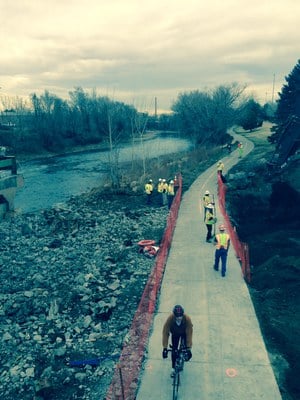Section 4(f)
Section 4(f) was created when the United States Department of Transportation (US DOT) was formed in 1966. It was initially codified in Section 4(f) of the USDOT Act of 1966, which is where it got its name. Here is a summary of the substance of the law:
Section 4(f) of the US DOT Act of 1966, codified in Federal law at 49 U.S.C. 303, declares that it is the policy of the United States Government that special effort should be made to preserve the natural beauty of the countryside and public park and recreation lands, wildlife and waterfowl refuges, and historic sites.
Section 4(f) specifies that the Secretary [of Transportation] may approve a transportation program or project . . . requiring the use of publicly owned land of a public park, recreation area, or wildlife and waterfowl refuge of national, State, or local significance, or land of an historic site of national, State, or local significance (as determined by the Federal, State, or local officials having jurisdiction over the park, area, refuge, or site) only if:
- there is no prudent and feasible alternative to using that land; and
- the program or project includes all possible planning to minimize harm to the park, recreation area, wildlife and waterfowl refuge, or historic site resulting from the use.
Section 4(f) further requires consultation with the Department of the Interior and, as appropriate, the involved offices of the Departments of Agriculture and Housing and Urban Development in developing transportation projects and programs which use lands protected by Section 4(f).
Since 1966, Section 4(f) has undergone several changes. The most substantive change occurred in 2005 as part of the Safe, Accountable, Flexible, Efficient Transportation Equity Act: A Legacy for Users (SAFETEA-LU). Section 6009 of this act, amended existing Section 4(f) legislation to simplify the process and approval of projects that have only de minimis impacts on lands protected by Section 4(f). Under the new provisions, once the US DOT determines that a transportation use of Section 4(f) property results in a de minimis impact, analysis of avoidance alternatives is not required and the Section 4(f) evaluation process is complete. Section 6009 also required the US DOT to issue regulations that clarify the factors to be considered and the standards to be applied when determining if an alternative for avoiding the use of a section 4(f) property is feasible and prudent. On March 12, 2008 FHWA issued a Final Rule on Section 4(f), which clarifies the 4(f) approval process and simplifies its regulatory requirements. In addition, the Final Rule moves the Section 4(f) regulation to 23 CFR 774.
Laws and Regulations
Title 49 U.S.C. Section 303
Title 23 U.S.C. Section 138
23 CFR 774
Final Rule on Section 4(f)
Technical Correction to Final Rule on Section 4(f)
For more information
FHWA Section 4(f) Policy Paper
FHWA Section 4(f) Nationwide Programmatic Evaluations
FHWA Section 4(f) at a Glance
FHWA Section 4(f) Tutorial
CDOT NEPA Manual
CDOT Section 4(f) De Minimis Guidance
